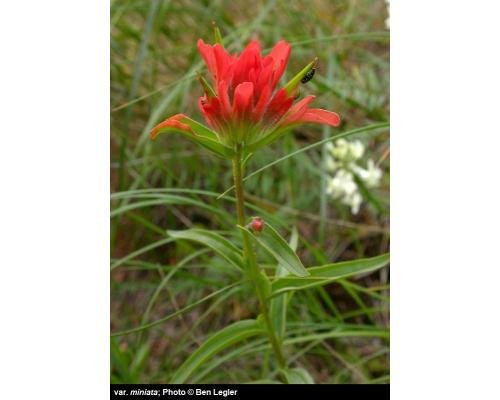Giant Red Indian Paintbrush
Castilleja miniata
zones 3-7
75 seeds
Castilleja miniata is a species of Indian paintbrush native to western North America ranging from Alaska to California to New Mexico. It is found in a wide variety of habitats, but generally prefers moist places. It is commonly found in wet mountain meadows and stream banks below 11,000 ft. This perennial plant grows to about 30”. Leaves are fuzzy and lance-shaped. The inflorescence is made up of bright red to pale orange or orange-tipped bracts. Between the bracts yellow-green, red-edged tubular flowers emerge May-September.
A unique trait of most plants in this family is that they are hemiparasites,
or partial parasites. These plants obtain some of their food from a host, and also produce their own food through photosynthesis. Because of the complex networks formed between plants, Indian Paintbrush is nearly impossible to transplant and a fun challenge to grow from seeds.
Seeds are best sown in the autumn directly outdoors into garden of fine soil. The minute seed should be mixed with potting soil, then broadcast onto the prepared area and gently watered in. Stored seeds will need cold stratification for 3-4 months and sown as early as possible in the spring. Germination, especially of stored seed, is slow. Plants will not flower until the second or third year.
Castilleja miniata
zones 3-7
75 seeds
Castilleja miniata is a species of Indian paintbrush native to western North America ranging from Alaska to California to New Mexico. It is found in a wide variety of habitats, but generally prefers moist places. It is commonly found in wet mountain meadows and stream banks below 11,000 ft. This perennial plant grows to about 30”. Leaves are fuzzy and lance-shaped. The inflorescence is made up of bright red to pale orange or orange-tipped bracts. Between the bracts yellow-green, red-edged tubular flowers emerge May-September.
A unique trait of most plants in this family is that they are hemiparasites,
or partial parasites. These plants obtain some of their food from a host, and also produce their own food through photosynthesis. Because of the complex networks formed between plants, Indian Paintbrush is nearly impossible to transplant and a fun challenge to grow from seeds.
Seeds are best sown in the autumn directly outdoors into garden of fine soil. The minute seed should be mixed with potting soil, then broadcast onto the prepared area and gently watered in. Stored seeds will need cold stratification for 3-4 months and sown as early as possible in the spring. Germination, especially of stored seed, is slow. Plants will not flower until the second or third year.
Castilleja miniata
zones 3-7
75 seeds
Castilleja miniata is a species of Indian paintbrush native to western North America ranging from Alaska to California to New Mexico. It is found in a wide variety of habitats, but generally prefers moist places. It is commonly found in wet mountain meadows and stream banks below 11,000 ft. This perennial plant grows to about 30”. Leaves are fuzzy and lance-shaped. The inflorescence is made up of bright red to pale orange or orange-tipped bracts. Between the bracts yellow-green, red-edged tubular flowers emerge May-September.
A unique trait of most plants in this family is that they are hemiparasites,
or partial parasites. These plants obtain some of their food from a host, and also produce their own food through photosynthesis. Because of the complex networks formed between plants, Indian Paintbrush is nearly impossible to transplant and a fun challenge to grow from seeds.
Seeds are best sown in the autumn directly outdoors into garden of fine soil. The minute seed should be mixed with potting soil, then broadcast onto the prepared area and gently watered in. Stored seeds will need cold stratification for 3-4 months and sown as early as possible in the spring. Germination, especially of stored seed, is slow. Plants will not flower until the second or third year.

